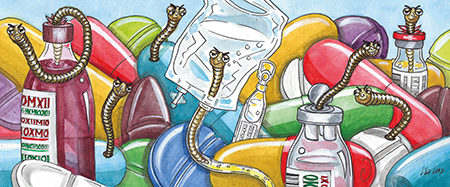Abstract
- To make it easier to choose quality care, and to prevent disproportionate harms to patients, Prescrire has published its annual update of drugs to avoid in the name of better care.

- Prescrire's assessments of the harm-benefit balance of drugs in given situations are based on a rigorous procedure that includes a systematic and reproducible literature search, identification of patient-relevant outcomes, prioritisation of the supporting data based on the strength of evidence, comparison with standard treatments, and an analysis of both known and potential adverse effects.
- This annual review of drugs to avoid covers all the drugs examined by Prescrire between 2010 and 2017 that are authorised in the European Union or in France. We identified 90 drugs (79 of which are marketed in France) that are more harmful than beneficial in all the indications for which they have been authorised.
 In most cases, when drug therapy is really necessary, other drugs with a better harm-benefit balance are available.
In most cases, when drug therapy is really necessary, other drugs with a better harm-benefit balance are available.
- Even in serious situations, when no effective treatment exists, there is no justification for prescribing a drug with no proven efficacy that provokes severe adverse effects. It is sometimes acceptable to test these drugs in clinical trials, but patients must be informed of the uncertainty over their harm-benefit balance and of the trial's objectives. Tailored supportive care should be used when there are no available treatments capable of improving prognosis or quality of life, beyond their placebo effect.
NOTABLE CHANGES IN THE 2018 UPDATE Three drugs from Prescrire's 2017 review of drugs to avoid are no longer available or no longer authorised: strontium ranelate, for osteoporosis, was withdrawn worldwide in mid-2017 by the pharmaceutical company that markets it (Prescrire Int n° 183); the dexamethasone + salicylamide + hydroxyethyl salicylate combination in sprains or tendinopathy (withdrawn by the company in France), and catumaxomab for malignant ascites (EU marketing authorisation withdrawn at the company's request).
Canagliflozin and omalizumab: Prescrire reviewing new data in 2018. Some drugs listed in last year's review of drugs to avoid, compiled in early 2017, have been dropped from this year's review, pending the outcome of our reassessment of their harm-benefit balance.
- We are currently analysing new data published on canagliflozin, and because dapagliflozin has a similar mechanism, both drugs have been removed from this year's update.
- We are also re-examining the harm-benefit balance of the recombinant anti-IgE monoclonal antibody omalizumab in severe asthma; and because mepolizumab has a similar mechanism and similar adverse effects, this anti-interleukin-5 monoclonal antibody has also been removed from this year's review.
Additions: metopimazine, nifuroxazide. We analysed the cardiac adverse effects of metopimazine in 2017. This neuroleptic of the phenothiazine class is commonly used in France as an antiemetic, and about 4 million patients in France were exposed to it in 2016, most of whom had gastroenteritis. The little data available show that it can provoke serious cardiac disorders (including syncope, arrhythmias and sudden death). These are unacceptable reactions for a drug taken to relieve transient nausea and vomiting (to be published in Prescrire Int, May issue).
Four other drugs have been added because their harm-benefit balance is unfavourable in all their approved indications:
- the intestinal "anti-infective" agent nifuroxazide;
- the fixed-dose combination conjugated equine oestrogens + bazedoxifene in menopausal symptoms;
- roflumilast for severe chronic obstructive pulmonary disease;
- and selexipag for pulmonary arterial hypertension.
|
©Prescrire 1 April 2018
free"Towards better patient care: drugs to avoid in 2018" Prescrire International 2018; 27 (192): 107-1 - 107-9 (Pdf, free)
| Share |
 |
 |
